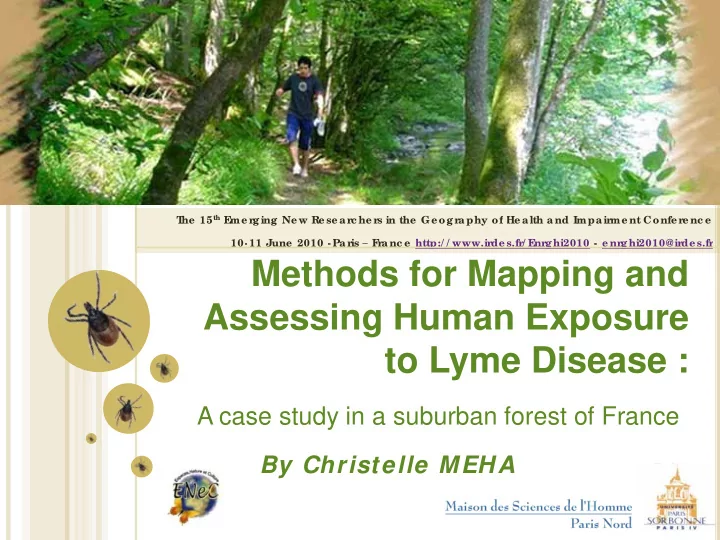

he 15 th E he 15 th E T T me r me r ging Ne w Re se ar ging Ne w Re se ar c he r c he r s in the Ge ogr s in the Ge ogr aphy of He alth and Impair aphy of He alth and Impair me nt Confe r me nt Confe r e nc e e nc e 10- 11 June 2010 - Par 10- 11 June 2010 - Par is – F is – F r r anc e http:/ / www.ir anc e http:/ / www.ir de s.fr de s.fr / E / E nr nr ghi2010 - e nr ghi2010 - e nr ghi2010@ir ghi2010@ir de s.fr de s.fr Methods for Mapping and Assessing Human Exposure to Lyme Disease : A case study in a suburban forest of France By Christelle MEHA
P RESENTATION OUTLINE What is Lyme disease (LD) ? 1. Some issues for the assessment of LD risk 2. Methods for assessing human exposure to LD 3. Conclusions and perspectives 4. Page 2
1. What Is Lyme Disease ? Most common vector-borne disease in the Europe and the U.S Transmitted by the bite of an infected tick A disease that can cause skin, joint, heart and nervous system problems Lyme disease can affect people of all ages Named after the town of Lyme, Connecticut, where it was first described in 1977 Page 3
1. What Is Lyme Disease ? The key components of the pathogenic system Source : Talaro, 2005 Page 4
2. Some Issues for the Assessment of Lyme Disease Risk A public health issue in suburban areas Encroachment of human settlement into the forest areas A large number of people who visit urban forests SOCIETY FOREST Increase of human-tick contact Disease emerged when humans moved into tick environment Page 5
2. Some issues for the assessment of Lyme disease risk Lyme disease risk exposure Vector Users Tick Woodlands Human Society Page 6
2. Some Issues for the Assessment of Lyme Disease Risk A major indicator : human-tick contact Field data collection framework Vector Human Spatial distribution dimension design Spatio-temporal analysis of human-tick contact A case study in the Forest of Sénart (near from Paris) Page 7
3. Methods for Assessing Human Exposure to Lyme Disease Examples of ticks habitat - Workpackage - Ticks collection methodo- logy (drap sampling) 9 forest stands Statistical Analysis - densities of ticks (per ha) - densities of infected ticks - infection prevalence Ticks are abundant in moist fern habitat fern fern Ticks live on Ticks Ticks the edge Acknowledgement : Ticks sampling Institut Pasteur (Paris), CNR of Borrelia Page Page 8
3. Methods for Assessing Human Exposure to Lyme Disease Data collection on visitors and their activities inside the forest Forest users Personal interviews Collected data Courtesy of Hedi Haddad Page 9
3. Methods for Assessing Human Exposure to Lyme Disease Disease The « routes » the visitors follow in the forest of Sénart » the visitors follow in the forest of Sénart Virtual geographic Virtual geographic Virtual geographic Virtual geographic environment environment Attendance intensity per section - Type of planting - Forest stations - Recreation areas Sample of 187 persons Page 1 0 Page 1 0 1 0
3. Methods for Assessing Human Exposure to Lyme Disease Accessibility into the understory Good accessibility Risk of human exposure + + + + No accessibility « Attractors » No accessibility Daffodils, Lily of the valley, mushrooms, etc. Page 1 1
4. Conclusions and Perspectives - Human itineraries - Human itineraries - Outdoor recreational activities - Outdoor recreational activities Data - Ticks habitat suitability - Ticks habitat suitability Collected - Accessibility (into the understory) - Accessibility (into the understory) analysis data - Forest attractors - Forest attractors - Tick-infested habitats - Tick-infested habitats Risk Forest - Patterns of activities - Patterns of activities assessment planning - Spatial design of the forest - Spatial design of the forest maps Outcome benefit : to develop a multi-agent geosimulation tool allowing forest officers to Outcome benefit : to develop a multi-agent geosimulation tool allowing forest officers to assess different intervention scenarios assess different intervention scenarios A special thank to Vincent Godard, Olivier Thomas, Hedi Haddad, Bernard Moulin This research is supported by the Île-de-France Region (PICRI, 2010-2012, n°09003396) Page 1 2
THANK YOU FOR YOUR ATTENTION ! Source : EUCALB, 2006 You can prevent Lyme Disease by keeping ticks off your body ! But we geographers can minimize Lyme Disease risk using the landscape and design ! Page 1 3
Recommend
More recommend